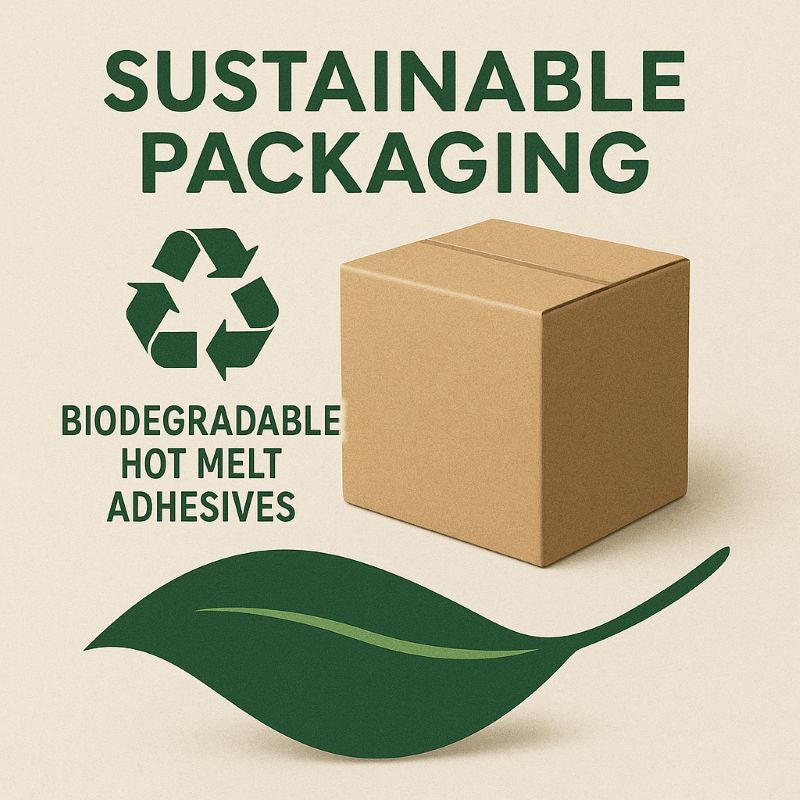
Understanding Sustainable Packaging
Definition of Biodegradable Adhesives
Types of Biodegradable Hot Melts
Importance of Sustainable Packaging
Methods for Adhesive Application
Latest Trends in Sustainable Packaging
Strategies for Implementation
Frequently Asked Questions (FAQ)
Sustainable packaging is an essential focus for modern businesses aiming to reduce environmental impact. A key component of this movement is the use of biodegradable hot melt adhesives, which offer an eco-friendly alternative to traditional adhesives. These adhesives are designed to break down naturally, helping to minimize waste accumulation in landfills. In addition to supporting environmental goals, they deliver strong bonding performance suitable for various packaging needs.
Biodegradable adhesives are specially formulated bonding materials that decompose naturally over time through biological processes. Unlike conventional adhesives that may persist for decades in the environment, these alternatives reduce long-term ecological harm. They are typically derived from renewable resources and are free of harmful chemicals, making them a preferred choice for environmentally conscious packaging systems. Their adoption supports cleaner production and contributes to a circular economy.
There are several types of biodegradable hot melt adhesives available to support different packaging requirements. These may include:
General-purpose formulations: Ideal for a wide range of packaging applications.
Heavy-duty variants: Designed for strong adhesion in challenging conditions.
Fast-setting types: Useful for high-speed production lines where efficiency is critical.
Low-impact blends: Formulated for sensitive or delicate materials.
Each type is engineered to deliver specific benefits, such as speed, strength, or gentleness, while still ensuring that the adhesive is compostable or biodegradable under appropriate conditions.
Sustainable packaging plays a critical role in reducing the environmental impact of consumer goods and industrial products. By using biodegradable adhesives, manufacturers can significantly lower their ecological footprint. These adhesives help eliminate harmful residues, reduce dependence on fossil-based raw materials, and align packaging operations with sustainability certifications and consumer expectations. Implementing such practices demonstrates corporate responsibility and can enhance brand value.
The method of applying biodegradable hot melt adhesives can significantly affect their performance and sustainability:
Spot application allows for targeted bonding with minimal material use.
Bead application creates continuous lines for secure edge sealing.
Spray application is efficient for covering larger surfaces evenly.
Choosing the right application method ensures not only functional integrity but also optimized adhesive consumption, thereby reducing both material waste and environmental impact.
Current trends in sustainable packaging highlight the growing integration of biodegradable hot melt technologies. Innovations are focused on improving adhesive strength, reducing curing time, and enhancing compatibility with recyclable and compostable packaging substrates. Manufacturers are also exploring hybrid adhesives that maintain high-performance standards while meeting compostability criteria. As legislation and consumer demand shift toward greener solutions, such adhesives are becoming central to packaging design strategies.
To effectively integrate biodegradable adhesives into packaging operations:
Assess packaging requirements to determine adhesive strength, speed, and environmental compatibility.
Select the right adhesive type based on material and production constraints.
Choose an appropriate application method (e.g., spot, bead, or spray).
Train staff on sustainable adhesive use, storage, and safety.
Monitor and evaluate sustainability metrics such as waste reduction and carbon footprint improvements.
These steps ensure that sustainable goals are met without compromising operational efficiency or product quality.
What are biodegradable adhesives?
They are adhesives made from renewable or compostable components designed to break down naturally, minimizing long-term environmental impact.
Why are biodegradable hot melt adhesives important?
They provide strong bonding performance while reducing ecological harm, supporting sustainable packaging initiatives.
What types of biodegradable hot melt adhesives exist?
Available types include general-purpose, heavy-duty, fast-setting, and gentle formulations tailored to specific packaging applications.
How can businesses implement these adhesives effectively?
By evaluating their needs, selecting suitable adhesive types and application methods, and providing staff training on proper handling and usage.
What application methods are most common?
Spot, bead, and spray applications are the most commonly used techniques, each suited for different operational scenarios.
What are the latest trends in sustainable packaging adhesives?
The latest trends include improved biodegradability, shorter setting times, compatibility with recyclable packaging, and the use of hybrid bio-based materials.
How do biodegradable adhesives help the environment?
They reduce landfill waste, lower reliance on petroleum-based materials, and contribute to circular production systems.
Can biodegradable adhesives match the performance of traditional adhesives?
Yes. Advances in formulation technology have allowed many biodegradable adhesives to meet or exceed the performance of traditional options in specific applications.